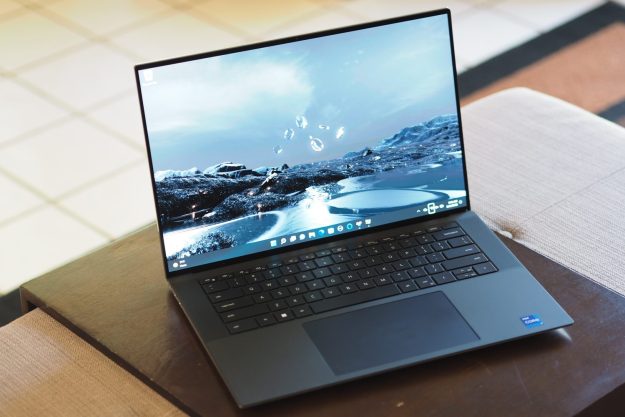The Dell XPS 13 was released at CES 2015, and immediately won a pack of awards — including Digital Trend’s Best Of Computing for that year’s show. It was a truly innovative laptop, sleek and light, built with materials not found elsewhere.
Now, Dell has finally produced a 2-in-1 version of the XPS 13, and revealed the new laptop at CES. First, the bad news; it’s not as innovative as the XPS 13. The company took its time converting that laptop’s formula to a 2-in-1, so its introduction comes well after competitors like the HP Spectre x360, which is on its second generation.
Now the good news: It’s still our favorite laptop. Fortunately for Dell, its peers still haven’t caught up to the original XPS 13, so, translating it to a 2-in-1 form factor still works well.
Great laptop, great 2-in-1
It’s a very direct translation. Closed, and side-by-side, it’s hard to tell the two apart. Just two traits give the 2-in-1 away. It’s thinner and lighter, reducing thickness to 0.54 inches at most, and 0.32 inches at least (the body is generously tapered). And the 2-in-1 has a pair of 360-degree hinges, rather than the single wide hinge on the XPS 13.
Opening the 2-in-1 reveals more similarities, including many that we’re glad to see. The soft-touch black interior remains, for example. And the keyboard, only slightly modified from the XPS 13, is excellent. Dell told us its designers considered going with a slim-travel keyboard, such as in the Asus Zenbook 3 and MacBook Pro 13, but they weren’t satisfied with the results. That’s why the XPS 13 2-in-1 isn’t quite as thin as its rivals.
When all the pros and cons are tallied, the Dell XPS 13 2-in-1 comes out looking like a winner.
Above the keyboard you’ll find the familiar InfintyEdge display. Its bezels are as thin as ever, at less than a half-inch thick, and the same 1080p or 3,200 x 1,800 resolution options are available. These displays are not the best in their category, but they’ve always scored well in our testing. We expect the 2-in-1 will be no different, as Dell says its displays are essentially the same as the optional touchscreens on the XPS 13.
One flaw does carry over, and that’s the location of the camera. It remains below the display when the system is used in laptop mode, which creates a weird camera angle during video calls. Dell says this can be fixed in the 2-in-1 by using it in tent mode, which flips the display and uses the keyboard as a stand. That’s an obvious Band-Aid, but it could work. While the camera is in the same location, it has been upgraded to support Windows Hello facial recognition.
The touchscreen is compatible with Dell’s active pen accessory. There’s unfortunately nowhere to put the pen when you’re not using it, as is true of most 2-in-1s. Nothing about the pen jumped out at us as exceptional, but it worked as expected, and is a relatively affordable $50 accessory.
Even performance emulates the XPS 13
Beyond the exterior similarities, there’s one major difference between the XPS 13 and the 2-in-1 – the processor. Dell has decided to go with the “Y-Series” chips, which used to be called Core M. These low-power processors are easier on battery, but deliver less performance than the mainstream Intel Core mobile chips, known as the “U-Series.”
The decision to go with Y-Series was complex, according to Dell. The company wanted to retain a great keyboard, the InfinityEdge display, and reasonable battery size. Going with Y-Series helped make this possible, because the chip can be passively cooled.
Of course, that also means performance will be lower than it might’ve been. Dell’s countering that argument by saying the XPS 13 2-in-1 is as quick as the original XPS 13. We’re not sure everyone will buy that line. More believable is Dell’s insistence that it has tuned its firmware to maximize the time the processor spends in higher power states, which should take an edge off any performance hit.
Aside from the processor, the 2-in-1 keeps all the XPS 13’s hardware, including use of super-fast NVMe solid-state drives. This is a great boon for the feel of the system, as it ensures most applications open in the blink of an eye. In real-world use, the 2-in-1 won’t feel slower than the standard XPS 13. That will only reveal itself in more demanding workloads.
Still a winner
When all the pros and cons are tallied, the Dell XPS 13 2-in-1 comes out looking like a winner. Scratch that – it is a winner.
Why? At Digital Trends, we look for a particular trait in 2-in-1s. It must be a solid laptop. While its Y-Series processor made us skeptical, our hands-on time convinced us this 2-in-1 will be exactly that. It’s just wonderful to use, with an awesome keyboard, a super-fast drive, and eye-catching display options. Compared to an HP Spectre x360 13-inch, our favorite recent 2-in-1, it feels more portable and more refined.
We’ll have to spend more time with the XPS 13 2-in-1 to render our final verdict, as we can’t test performance or battery life during our hands-on time. But the future of Dell’s latest looks promising. You can buy one today, starting at $1,000.
Highs
- Excellent design
- Pleasent keyboard
- Thin-bezel display is still awesome
- Fast everyday performance
Lows
- Only available with Intel Y-Series processors
Editors' Recommendations
- Dell XPS vs. Dell Latitude: here’s how to decide
- Dell XPS 14 or XPS 16? Here’s how to know which to buy
- 9 best laptops of 2024: tested and reviewed
- The best 2-in-1 gaming laptops for 2024
- Dell just hit reset on the XPS






